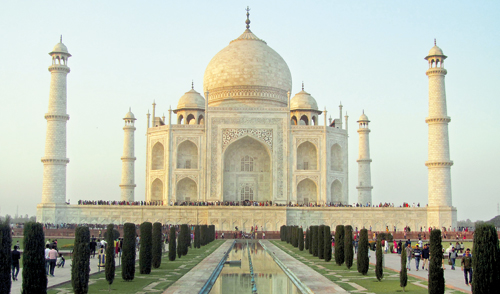Tarry awhile to savour this captured piece of magic

The Taj Mahal as the sun sets: Changing colours of a marvellous monument in marble:
It is India’s most popular tourist destination and attracts over seven million visitors each year. It is also that country’s most recognisable architectural icon.
In fact to most of the rest of the world, the Taj Mahal is THE emblem of India.
Built in the 17th century by the Mughal emperor Shah Jehan as a memorial to his favourite wife Mumtaz Mahal, it was completed in 1648. Twenty five years ago, in 1983, it was designated a World Heritage site by UNESCO.
Situated in the city of Agra about 200 km south of Delhi in the northern Indian state of Uttar Pradesh, the Taj Mahal is about four hours away from Delhi if you travel by car along the new Yamuna Expressway. You can also get there from Delhi by train (the Shatabdi Express) in a little over two hours. We ourselves did the trip to visit the Taj by car; we left Delhi after breakfast so that we could visit the massive Red Fort of Agra that afternoon and then, after an overnight stay in Agra, spend a relaxing full day at the Taj Mahal. If it is your first visit to India, it may be best to arrange your transport and hotel stay through a travel agent in Sri Lanka rather than take your chances with internet bookings.
Before planning your visit to the Taj, it would pay to study the official webpage – http://tajmahal.gov.in/ – so that you could find the latest information about ticket prices and opening hours. Sri Lankan and other SAARC country citizens pay more for their entrance tickets than Indian citizens – but much less than other foreigners. So don’t forget to take your passport with you when you visit.
The Taj is usually open from 30 minutes before sunrise and up to 30 minutes after sunset – so staying overnight in Agra allowed us to visit and witness the sight of this magnificent architectural marvel as the sun begins to wake up and then spend virtually the whole day there instead of rushing off to get somewhere else before nightfall.
Visitors are not allowed to go by car or trishaw to the main entrance at the East Gate. In order to minimise pollution that can damage and discolour the beautiful white marble of the Taj, fossil fuel powered motor vehicles have to stop about a kilometre from the main gates. The fifteen minute walk from Shilpgram is quite pleasant along a well paved pathway, and for those who cannot walk, electric-powered shuttle buses and cycle rickshaws are available.
Entering from the East Gate, you walk up to the Great Gate (Darwaza-i-Rauza) which is set in the southern wall of the funerary garden. Magnificent in its own right, this gate symbolises the passage from the forecourt to the funerary garden. This impressive structure cleverly hides the Taj itself until you actually come up to the entrance and then behold it beautifully framed in the archway.
Rabindranath Tagore expressed his thoughts about it thus: “The Taj Mahal rises above the banks of the river like a solitary tear suspended on the cheek of time.” I feel an even better description of this magnificent structure is that given by one of my friends. “The Taj Mahal” he said, after we had spent the better part of the day there, marvelling at how the marble mausoleum almost imperceptibly changed colour from dawn to dusk “can only be described as a captured piece of magic.”
The Taj Mahal itself is set in a tastefully designed garden, with trickling fountains – the octagonal building with minarets at its four corners being reflected in the pools of water in front of it. This mausoleum is magnificent when viewed as a whole, yet exquisite in the intricate detail of its designs that consist entirely of calligraphy and floral patterns made with semi-precious stones inlaid in the white marble.
Mumtaz Mahal’s mausoleum which is the main building is flanked by two almost identical buildings – the mosque to the west and the assembly hall on the east. Although the mausoleum is the dominant feature of the ensemble, the latter two buildings have been built as mirror images to complement and balance the architectural composition,.
If you decide to visit India, make sure you visit the Taj Mahal – no visit to India would be complete without it – but don’t do as many tourists do by spending just a couple of hours here before you are whisked away to see another of India’s tourist sights.
Tarry awhile and savour the beauty of this marvellous monument – the symbol of an emperor’s love for his favourite wife. Explore the gardens and the Taj museum, witness the marble slowly changing colour between sunrise and sunset, and be grateful for the privilege of being here.
It is, after all, truly a captured piece of magic.


